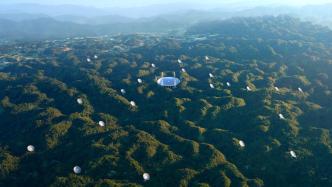

Artistic rendering of FRBs and host galaxies. China's "Sky Eye" (bottom left), the world's largest single-aperture radio telescope, and the Keck Telescope (top right), a single-aperture optical telescope with the highest spatial resolution, undertake the research and observation tasks. Drawings by Yu Jingchuan and Fu Hai
For 54 days and 82 hours, scientists used China's "Sky Eye" (FAST) to shoot a "big picture" of a "mysterious signal" outside the Milky Way, which lasted only a dozen seconds - Fast Radio Burst (FRB) 20201124A. Relevant research results were published in Nature on September 22.
The energy of the radio wave band that bursts instantaneously within a few milliseconds of a FRB is equivalent to the sum of the cumulative global power generation for tens of billions of years. Since the first discovery in 2007, scientists have so far detected thousands of such events. But exactly what their origins are, the answer is not entirely certain.
Scientists have dynamically monitored nearly 2,000 bursts of this extragalactic signal, and have made many first important discoveries in the world. "We found that it came from a place where the stars of the host galaxy are not so dense, where the magnetic field changes very strongly." Li Kejia, the corresponding author of the paper, a professor at Peking University and a researcher at the National Astronomical Observatory of the Chinese Academy of Sciences, told the Chinese Journal of Science.
"Using the world-class 'Sky Eye' telescope independently developed by my country, it is very exciting to be the first to see new phenomena that others have not seen yet, which is also the charm of scientific discovery." said Zhu Weiwei, the co-corresponding author of the paper and a researcher at the National Astronomical Observatory of the Chinese Academy of Sciences. , he is honored to have participated in the early commissioning of FAST since 2017, and participated in related research after the completion of the large plant.
On the same day, Wang Fayin, a co-author of the paper and a professor at the Department of Astronomy at Nanjing University, also modeled the observation in another study published in Nature-Communications. In addition to neutron stars), it provides evidence for the potential power source of the "binary origin" of FRBs.
Capturing Strange Phenomena
FRB 20201124A is an extragalactic signal detected by the 2020 Canadian Hydrogen Intensity Mapping Experiment (CHIME) telescope.
"This large-field telescope is very good at catching new fast radio storms. After we found that the signal was active, we immediately started to follow up." Zhu Weiwei told the "Science China Journal" that this is a case of international cooperation and information sharing in astronomy. Just as Wang Pei, an associate researcher at the National Astronomical Observatory of the Chinese Academy of Sciences, recently used FAST to discover another fast radio storm FRB 20121102A recurring and shared it with international colleagues in the "Astronomy Bulletin", doing so can allow astronomers all over the world to follow up the activity for the first time. celestial bodies, capture new phenomena.
For more than two months from April 1 to June 11, 2021, scientists used FAST to conduct continuous observations of FRB 20201124A for one hour a day.
"It's like making a movie, watching its physical evolution through radio." Zhang Bing, a professor at the University of Nevada, Las Vegas, co-corresponding author of the paper, said that with the rotation and revolution of the earth, in these two more During the month, the observation time slowly moves from 4:00 pm to the morning, and the last observation is 6:00 am.
According to reports, it is not difficult to calculate the observation time, as long as you "run the model twice" on the computer. Complicated is the analysis and processing of the vast amount of data acquired in the process—the dynamic pulse signals of 1,863 bursts observed over 54 days and 82 hours. Such a high rate of outbursts also makes the event one of the most active repeating outbursts. To understand what the data really say, researchers need to develop new theoretical models.
"The manuscript was received in July this year. Compared with the more than two months of observation, we have spent most of the past year and a half analyzing what information the obtained data can give us." Li Kejia said.
To the delight of the researchers, they finally observed many fast radio bursts that had not been discovered internationally.
This includes the first discovery of the strange evolutionary behavior of the Faraday rotation, that is, the Faraday rotation has an irregular short-time-scale evolution in the first 36 days, and is almost unchanged in the following 18 days; the first discovery of the rapid radio burst The phenomenon of extinction, that is, from maintaining a high burst state to suddenly extinguishing within 72 hours; for the first time, a high circular polarization pulse, which is significantly different from all previous fast radio bursts, was detected for the first time, and its highest value reached 75%; the polarization degree was also measured for the first time. A phenomenon that oscillates with the wavelength of an electromagnetic wave.
"These phenomena all show that the environment of 1 AU (that is, the distance from the sun to the earth) around FRB 20201124A is very complex and dynamically evolving." Li Kejia said.
He explained to the "Science China Journal" that the Faraday rotation can be used to understand the magnetic field strength in the environment, and the observed changes indicate that the magnetic field environment around the fast radio storm has undergone drastic changes. At the same time, through the phenomenon of polarization oscillation, they believed that the magnetic field around it reached the Gaussian level or more.
Prying into the mystery of the origin
This research also made the Chinese and Western telescopes "double swords" through international cooperation, complementing each other in the radio and optical bands, providing new evidence for the possible host environment and theoretical mechanism of FRBs.
"In the observation of FRB 20201124A, we also observed its host galaxy with the Keck 10-meter optical telescope in Hawaii, USA, and resolved the structure of the host galaxy for the first time, revealing its surrounding galaxy environment on a scale of several hundred light-years. ” Dong Subo, the co-corresponding author of the paper and a professor at Peking University, told the China Science Journal.
According to reports, the research team used spectral observations to determine the precise redshift of the host galaxy, which is estimated to be about 1.5 billion light-years away from Earth. Seeing such a distant host galaxy is no easy task due to atmospheric turbulence, with previous images showing only a blurry blob without discerning any structure within it. Through international cooperation with astronomers such as Fu Hai, a professor at the University of Iowa in the United States, and using the Keck telescope equipped with adaptive optics technology with advanced laser guide stars, the research team overcame the adverse effects and captured a clear image of the host galaxy for the first time. .
"This is a metal-rich barred spiral galaxy about the size of the Milky Way." Chen Ping, a co-author of the paper and a Ph.D. from Peking University, introduced to the China Science Journal that the so-called "barred spiral galaxy" refers to a "barred spiral galaxy" composed of stars. The bar-like structure runs through the spiral galaxy at the center of the galaxy. The study found that the source of the fast radio bursts in this study is not on the "rod", nor on the spiral arms of the "vortex", but is located between the spiral arms, at a moderate distance from the center of the galaxy, and is located on the galaxy disk with a relatively low density of stars. area.
What are the scientific implications of understanding the structure of host galaxies and the galactic environment around FRBs?
The host galaxies of repetitive FRBs previously captured by scientists, whether from dwarf galaxies much smaller than the Milky Way or spiral galaxies similar to the Milky Way, are mostly located near dense birthplaces of large numbers of young stars. To this end, some scientists have hypothesized that fast radio bursts may be related to ultra-bright supernovae caused by extreme explosions of massive stars or young magnetars formed after gamma-ray bursts.
"But our research shows that this repeated burst event is in a relatively ordinary galaxy environment." Dong Subo said, which means that the galaxy environment of this repeated burst does not support the above hypothesis.
In the study published in Nature Communications, Wang Fayin and collaborators modeled and analyzed the potential power source of FRB 20201124A based on observational data.
So far, scientists have established more than 60 models of the origin of FRBs, such as magnetars, neutron star mergers or neutron star and asteroid collisions. In 2020, Chinese and foreign scientists identified for the first time that the FRB 200428 in the Milky Way originated from a magnetar; however, most of the FRBs come from outside the Milky Way, and their origins have not yet been verified.
Fayin Wang and his collaborators found that the Faraday rotation contributed by the surrounding environment of FRB 20201124A changes sign, indicating that the magnetic field around it changes direction, a phenomenon similar to that of the PSR B1259-63/LS 2883 binary in the Milky Way. "This suggests that it may come from a binary star system consisting of a magnetar and a Be star (a B-type star with obvious hydrogen emission lines in its spectrum)," he told the China Science Journal.
They also found that the event was the first recurring FRB with circular polarization and the longest duration. "Generally, the average time of a radio burst is only a few milliseconds, but this time it can reach about 15 milliseconds, which is an order of magnitude higher." Wang Fayin said by comparison, this may be due to the fact that when the radiation of the fast radio burst passes through the Be star disk, it interacts with the electrons on the disk. The scattering that occurs results in a longer duration of FRBs. In addition, there is a significant change in the Faraday rotation, accompanied by depolarization, which may be caused by the unevenness of the material and magnetic field on the disk, resulting in different Faraday rotation values in different line-of-sight directions.
According to reports, the model can explain the Faraday rotation evolution of the other three newly discovered fast radio bursts (FRB 190520B, FRB 180916 and FRB 220529). "This model provides strong evidence that some FRBs may originate from binary star systems, and is of great value to the field," commented one reviewer.
approaching the truth
After the first fast radio burst was discovered in 2007, some scientists estimated that only one radio burst can be seen every 10 years. However, in the past few years, the systematic and large-scale development of large-field telescopes has changed the field of research rapidly. Hundreds of FRBs have been published around the world, and the number of FRBs that have been discovered has actually reached thousands.
"Thanks to FAST, a great power, Chinese scientists have been making new discoveries in the field of fast radio storm research in the past few years, and have been active at the forefront of the world," said Zhu Weiwei.
However, he said there are still many questions to be answered. For example, what is the origin of FRB? Why are there so many explosions? This requires the combination of astronomical observations and theoretical modeling, constantly discovering new phenomena and possibilities, and approaching the truth step by step.
In order to achieve this goal, Li Kejia said that in addition to FAST, infrastructure such as the "Smart Eye" hard X-ray space telescope and the "Tian Lai" telescope experimental array will gradually solve the problem of insufficient multi-band observation capabilities in astronomical observations. "It is expected that our cooperative team of nearly 100 people can rely on FAST to lead more international joint observations, produce more important results in the next few years, find the real source, and contribute to the understanding of this violent astrophysical phenomenon." He said.
Wang Fayin suggested strengthening the training of fast radio storm research talents. He told reporters that at present, most researchers in this field are transferred from pulsar research, and the overall strength of the talent team is still insufficient.
Related paper information:
https://doi.org/10.1038/s41586-022-05071-8
https://doi.org/10.1038/s41467-022-31923-y
(Original title "China's "Sky Eye" Shoots "Blockbuster" for Mysterious Signals")


